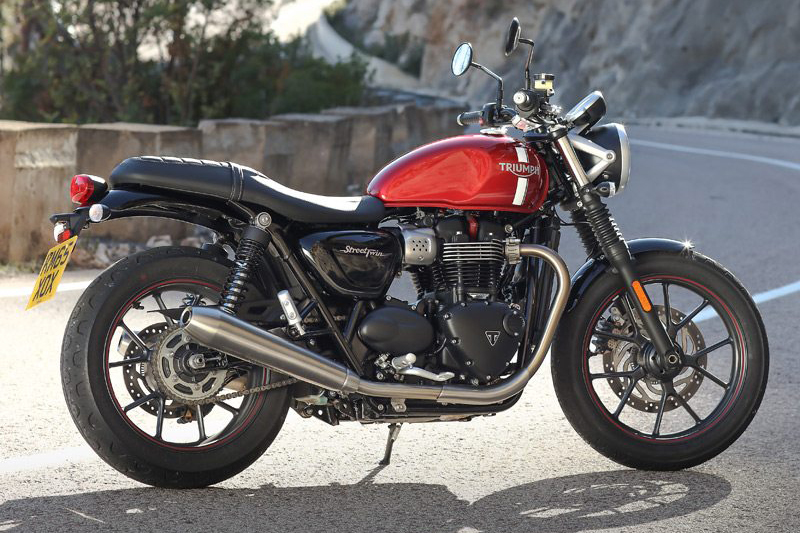2016 Triumph Street Twin

First Ride Review
At Milan’s EICMA Show last November (2015), Triumph presented five new parallel-twin motorcycles powered by all-new liquid-cooled engines—one 900cc model, and four 1,200cc big twins. These collectively represent the next generation of its iconic Bonneville family of retro models, one of the core products of its model lineup.
I had the chance to spend a day in Spain riding the first of the five new models to reach production, the 900 Street Twin, which is essentially Triumph’s entry-level model to the Bonneville family. Just throwing a leg over its 29.5-inch seat makes you realize straightaway this is a better thought-out and more accessible bike than any previous Bonneville, because while 0.4-inch higher than the outgoing T100’s perch, it actually feels lower thanks to the way it’s been narrowed where it meets the slightly smaller fuel tank. Shorter riders, many of them female, will welcome being able to place both feet flat on the ground at stoplights. Yet at 5-foot, 10-inches tall I didn’t feel at all cramped, because there’s lots of room to move around the bike, plus the seat itself has been redesigned to incorporate more substantial foam for a comfier mile-eating posture.
Also, the reach forward to the shorter, flatter one-piece steel handlebar with adjustable brake and clutch levers is shorter compared to the old bike–you feel as if you’re seated farther forward, and although the handlebar is closer to you, it asks you to lean slightly farther forward than with the more pulled-back bar of the old bike. Plus the footrests feel positioned slightly farther back, so you’re encouraged to ride with your toes parked on the pegs, with knees tucked in tight to the flanks of the tank—you feel more a part of the Street Twin than before, and it’s a very untiring place to be thanks to the complete lack of vibration at any revs from the all-new parallel-twin motor with 270-degree crank, up to and including the redline. The fuel tank is well shaped, so you grasp it cozily with your knees, plus the retro-looking round mirrors give a good view, and don’t vibe. This bike was obviously developed and refined by people who rode it a lot.
This is a bike it’s good to be aboard. Thumb the clever combined kill switch and starter button to send the liquid-cooled engine into life, and relish the unexpectedly glorious note of the stock Street Twin’s exhaust. Next, savor the extremely light and ultra-controllable lever action of the cable-operated oil-bath slip/assist clutch, which makes riding in traffic or city streets completely untiring, with no undue wear and tear on your left hand owing to an unreasonably stiff clutch action. The gearbox shift action is fully up to Japanese quality, and the light, precise clutch action makes it easy to make quick getaways from traffic lights or stop signs, even if with peak power of 54 horsepower delivered at 5,900 rpm, the 900cc Street Twin motor has just three-quarters of the horsepower of the outgoing 865cc Bonnie. If you want more, Triumph will refer you to the array of four 1,200cc models coming shortly to a showroom near you.
This doubtless explains why Triumph refused to reveal the new 900HT (as in High Torque) engine’s power figures at its EICMA Show debut, fearing that outsiders would assume that the only way they could meet Euro 4 requirements was by detuning the bike. Nothing of the kind, as my day’s ride proved–for what matters most in real-world riding is the fact that by contrast there’s a claimed 18-percent more torque than the outgoing T100 model, peaking as low as 3,230 rpm when 59 lb-ft is available, and thereafter widely spread across the whole rev range. It’s really noticeable how much more low-down grunt there is on this bike vs. the old.
That also explains why there’s no tachometer incorporated in the Street Twin’s single analog instrument with digital info panel, because Triumph’s R&D team headed by Stuart Wood (click here to read my interview with him) isn’t interested in telling you how many revs the engine is turning so you can aim for the redline in each gear–they just want you to go with the flow and relish riding that torque curve, if necessary using the 5-speed gearbox with evenly spaced ratios to do so. But holding second gear proved an ideal attack mode for long stretches of switchbacked Spanish country roads, with the rev limiter only intruding with 70 mph shown on the speedo, and still no vibes from the engine even when pressed as hard as the 105 mph I saw briefly in top gear. But the Street Twin really didn’t want to be going that fast–70-80 mph top gear cruising is where it’s most at home. Five speeds in the gearbox are quite sufficient for something this torquey, by the way–I never caught myself looking for another ratio. But less satisfactory was the rather abrupt pickup from a closed throttle when exiting a turn in second gear–it’s fine in the other ratios, just noticeable in this one where I suspect Wood & Co. wanted to maximize low-speed pickup and acceleration via some quite aggressive engine mapping. For while the single throttle body’s butterfly delivers a super-light throttle action that’s also untiring, the quite brusque pickup bordering on jerkiness from a closed throttle in second gear is the only real dynamic criticism that I have of the Street Twin.
The Street Twin’s handling is capable and confidence inspiring, and much improved over the outgoing model thanks to its considerably tighter steering geometry, and especially the two-inch (54mm) shorter wheelbase. The low center of gravity helps it ride bumps well on the angle, and it’s extremely agile in flicking from side to side in a succession of curves. And in spite of asking just a single 310mm front disc and 255mm rear, each gripped by a twin-piston Nissin caliper, to stop a bike weighing 437 pounds dry from relatively high speed, I can confirm that the Street Twin’s braking package will do the business when called upon to stop in panic mode. But the single disc not only reduces cost and speeds up the steering thanks to a reduced gyroscopic effect, it also enhances suspension response, because of the reduction in unsprung weight.
Indeed, the biggest dynamic improvement in handling terms of the Street Twin over the old cast-wheel Bonneville T100 is in many ways in the suspension, where Triumph’s chassis development guru David Lopez has done a superb job in teaming with Kayaba’s technicians to produce a twin-shock motorcycle with non-adjustable suspension damping front and rear which has a level of compliance that’s worthy of a much more expensive and sophisticated variable-rate monoshock bike. Riding through the streets of Valencia at the start of our day’s ride, I went looking for manhole covers to test the damping, and was so impressed by the way the Triumph ate up the bumps I thought I must have just assumed I was riding a twin-shock neo-retro model, and that Triumph had monoshocked the bike. Closing up on David’s bike, I peered at the rear end and…yes, still a twin-shocker. Wait till you ride it and tell me you’re not impressed with the settings he’s chosen for the suspension, which by definition will be the ones that customers are delivered with thanks to the non-adjustability of the fork and shocks (well, except for preload on the latter).
For countless years, horsepower has ruled as the be-all-and-end-all of two-wheeled satisfaction – but the times they are a-changing. For with sportbike sales slumping globally for all sorts of reasons, replaced in motorcyclists’ affection by Naked-as-Nature real world rides, torquey twins like the new family of Triumph Bonnevilles are becoming increasingly mainstream models appealing to a different kind of rider who arguably now represents a motorcycle dealer’s core customer. He or she will want to personalize the bike via Triumph’s 150-strong list of factory accessories, or customize it beyond that in a way that individualizes it. The Street Twin’s stripped-back styling, distinctive sound and dynamic riding experience enhanced by the addition of electronic riding aids including ABS and traction control plus a ride-by-wire throttle, makes it a successful modern reinterpretation of Triumph’s most iconic model. Job well done, chaps.
